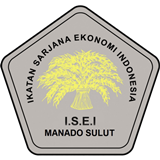ANALISIS BREAK EVEN POINT (BEP)
DOI:
https://doi.org/10.32400/jiam.5.1.2021.34692Keywords:
break even points, break-even point, profit planningAbstract
This paper aims to provide information to the public regarding the meaning, use, purpose, limitations, and methods of calculating Break Even Point Analysis (BEP). Management needs information that can be used as a basis for planning company profits. By knowing the break-even point, management can determine the amount of production or sales that must be made, according to the profit target to be achieved). Due to the Covid-19 pandemic, the data collection technique used is an online study, namely by taking references from the Internet. The type of data used is secondary data in the form of books related to the discussion, of course, books/materials on the internet. Data analysis used descriptive method, which was to describe the research results and then draw conclusions. Break Even Point (BEP) calculation can be done by equation method, contribution margin method, and graphical method. The three methods when used produce the same number. Break Even Point (BEP) analysis, in practice, besides containing benefits but also contains weaknesses.
References
Anderson, D. R., Sweeney, D. J., Williams, T. A., Camm, J. D., Cochran, J. J., Fry, M. J., & Ohlmann, J. W. (2019). An introduction to management science: Quantitative approaches to decision making, 15th Edition. Boston: Cengage Learning, Inc.
Blocher, E. J., Stout, D. E., & Cokins, G. (2010). Cost management: A strategic emphasis, 5th Edition. New York: McGraw-Hill/Irwin.
Block, S. B., Hirt, G. A., & Danielsen, B. R. (2017). Foundations of financial management, 16th Edition. New York: McGraw-Hill Education.
Chalil, D. C. (2018). Titik impas dan perencanaan laba. Jurnal Mitra Manajemen, 2(5), 438-448. https://doi.org/10.52160/ejmm.v2i5.135
Garrison, R. H., Noreen, E. W., & Brewer, P. C. (2018). Managerial accounting, 16th Edition. New York: McGraw-Hill Education.
Irfania, Y., & Diyani, L. A. (2016). Perbandingan full costing,variable costing terhadap HPP serta perhitungan titik impas UKM Tempe Papan Mas. Jurnal Mahasiswa Bina Insani, 1(1), 103-118. https://ejournal-binainsani.ac.id/index.php/JMBI/article/view/59
Julirin, M., Hasanuddin, & Koto, H. (2019). Analysis of efficiency and break even point of sawmill wood industry: Case study at UD. Timber Jaya Makmur Sukaraja, Seluma, Bengkulu. Jurnal Agroindustri, 9(2), 102-108. https://doi.org/10.31186/j.agroindustri.9.2.102-108
Khanifah, K. E., & Septiana, N. (2019). Profit planning analysis with Break Even Point approach (BEP) on banana chips business “Berkah Jaya†in Metro City. Fidusia: Jurnal Keuangan dan Perbankan, 2(2), 52-68. https://doi.org/10.24127/jf.v2i2.454
Makmur (2016). Analisis biaya produksi dan titik impas usaha kecil pembuatan sari jahe instan. Jurnal Cano Ekonomos, 5(1), 55-62. https://e-journal.upp.ac.id/index.php/Cano/article/view/1163
Maruta, H. (2018). Analisis Break Even Point (BEP) sebagai dasar perencanaan laba bagi manajemen. Jurnal Akuntansi Syariah, 2(1), 9-28. https://ejournal.stiesyariahbengkalis.ac.id/index.php/jas/article/view/129
Mokoginta, M., & Budiarso, N. (2017). Ipteks bagi masyarakat perencanaan pajak jangka pendek. Jurnal Ipteks Akuntansi Bagi Masyarakat, 1(1), 1-13. https://doi.org/10.32400/jiam.1.1.2017.19639
Mowen, M. M., Hansen, D. R., & Heitger, D. L. (2018). Managerial accounting: The cornerstone of business decision making, 7th Edition. Boston: Cengage Learning.
Nata, A. A. L., Riani, N., Marantika, A., & Apriani, E. (2021). Perencanaan laba dengan titik impas sebagai dasar pengambilan keputusan bagi pihak pengelola CV. Randu Sari Satu. Derivatif: Jurnal Manajemen, 15(1), 43-56. https://fe.ummetro.ac.id/ejournal/index.php/JM/article/view/579
Sugiarti, S. (2005). Analisis titik impas dan keuntungan usaha tani karet di Desa Talang Perapat Kecamatan Seluma Barat Kabupaten Seluma. Jurnal AGRISEP, 4(2), 28-32. https://ejournal.unib.ac.id/index.php/agrisep/article/view/647
Suswadi, S. (2018). Analisis titik impas, tingkat efisiensi dan tingkat karakteristik pertanian organik di Boyolali. Jurnal Ilmiah Agrineca, 18(2), 43-58. http://ejournal.utp.ac.id/index.php/AFP/article/view/765
Downloads
Additional Files
Published
Issue
Section
License
Authors who publish with this journal agree to the following terms:
- Authors retain copyright and grant the journal right of first publication with the work simultaneously licensed under a Creative Commons Attribution License that allows others to share the work with an acknowledgement of the work's authorship and initial publication in this journal.
- Authors are able to enter into separate, additional contractual arrangements for the non-exclusive distribution of the journal's published version of the work (e.g., post it to an institutional repository or publish it in a book), with an acknowledgement of its initial publication in this journal.
- Authors are permitted and encouraged to post their work online (e.g., in institutional repositories or on their website) prior to and during the submission process, as it can lead to productive exchanges, as well as earlier and greater citation of published work (See The Effect of Open Access).







